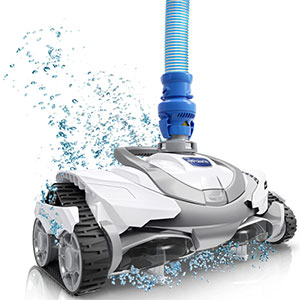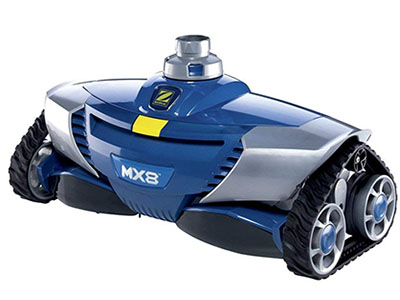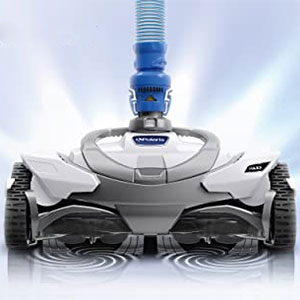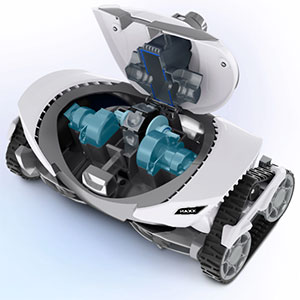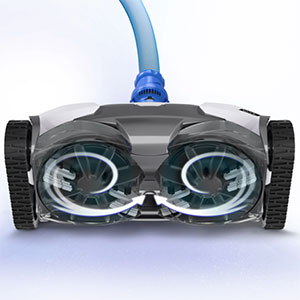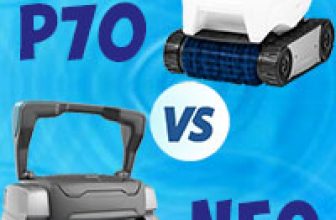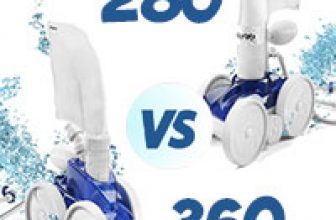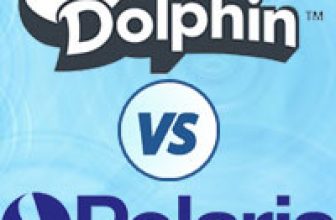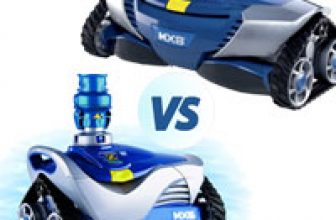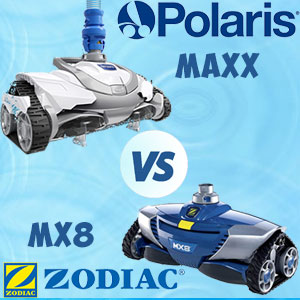 Swimming pools are not only entertaining and refreshing activities on a sunny day. It is also regular maintenance to keep the water clean and healthy, without debris, algae, and frogs. Every pool owner knows that pool cleaning requires special equipment, chemicals, and time. You need, first of all, a filter, a pump, and a skimmer to collect debris from the surface and prevent standing still water. Swimming in still water is unsafe as it contains harmful bacteria and algae, which are especially good to grow in such conditions.
Swimming pools are not only entertaining and refreshing activities on a sunny day. It is also regular maintenance to keep the water clean and healthy, without debris, algae, and frogs. Every pool owner knows that pool cleaning requires special equipment, chemicals, and time. You need, first of all, a filter, a pump, and a skimmer to collect debris from the surface and prevent standing still water. Swimming in still water is unsafe as it contains harmful bacteria and algae, which are especially good to grow in such conditions.
Additionally, several times per season, you must use chemicals – liquid or powder chlorine, to disinfect the water. Another way is to use a floater and add chlorine in tablets, which dissolve in small amounts daily and keep the required healthy chlorine level. You must also scrub the walls, floor, and waterline from dirt and algae. You can do this manually or purchase a cleaner. If you want to save time, you need to purchase an automatic pool cleaner. In this article, we review and compare two suction side cleaners – Polaris MAXX vs. Zodiac MX8.
Polaris MAXX vs. Zodiac MX8 – Comparison table
Main differences between models
Polaris and Zodiac are parts of a big swimming equipment production company – Zodiac Pool Systems LLC (Zodiac). That is why some of the pool cleaners are similar to each other but not exactly the same. About the main differences between Polaris MAXX vs. Zodiac MX8, you can read in this chapter; for similarities and a detailed product review, please examine further sections three and four.
- Polaris MAXX and Zodiac MX8 have similar construction but different designs. They have different colors, and Polaris has an additional protection shield for track wheels.
- Polaris drive technology is based on HALO Technology. Zodiac MX8 has Flex Power Turbine.
- The navigation control of Polaris is multi-directional, while Zodiac has maX-Drive navigation for 360 degrees advanced navigation without hang-ups.
- Zodiac is slightly smaller and lighter than Polaris MAXX.
- Polaris Maxx has two scrubbing brushes, while Zodiac MX8 has only two standards. Zodiac MX8 Elite has two scrubbing brushes in the package.
Detailed product review
In this part, we will review all details of these cleaners and check their pros and cons.
Polaris MAXX Premium Suction-Side Automatic Pool Cleaner
Polaris MAXX is revolutionary and the most advanced suction side cleaner on the market. It is designed for in-ground pools of all shapes. It has two active scrubbing brushes on the bottom that are suitable for all pool surfaces. They scrub debris on the surface and remove fine and stuck-on debris. It also can climb walls and clean a waterline. The tri-point track wheels are reinforced and protected with a shield to last longer. On the bottom, there is a debris opening to collect all types of debris using advanced HALO Technology. The multi-directional navigation ensures full pool coverage, while two powerful turbines are responsible for climbing abilities. The cleaner has two modes – large debris mode and small debris mode. You need to locate the inlet adapter in the vacuum inlet to switch between modes.
This cleaner is easy to maintain. You need to regularly push the button which opens the top lid. If you see algae or other debris, you must delete them. The cleaner has no filter as in robotic cleaners; some debris is collected on a turbine, and some are sent to the pool filter. The advanced design does not allow the large leaves or other big debris to clog the internals; it directs everything directly to the filtration system through the hose. If you don’t want to clog the pump basket, you may purchase the leaf canister separately.
To connect the Polaris to the dedicated suction port or skimmer (both dedicated for connection are included in the package), you need to use twelve blue 39″ hose sections. The length of the hose is enough for all pool sizes. The hose sections are easily connected; you need to push and twist the connector on two hoses. You need to measure the required number of hose sections; the length should be enough to reach from the skimmer or dedicated vacuum line port to the farthest point in your pool. All other sections should be removed. One of the 12 sections is a leader hose with a floater; it should be added to the required sections. The cleaner has an energy-efficient hydraulic design and can work at low flow rates.
- Works automatically
- No electricity is required for work
- Two types of connection to the suction side of the pump
- Long 39″ hose (12 sections)
- A small and light cleaner body
- A quick guide with pictures is included in the package
- Advanced HALO technology to eliminate all sizes of debris
- Active replaceable scrubbing brushes
- Can clean walls, floor, and a waterline
- The additional load on the pool pump, skimmer, and filter
- No built-in filter
Zodiac Suction Pool Cleaner (MX8)
Zodiac is another advanced suction side automatic cleaning robot for an extra clean swimming pool. It is also designed for in-ground pools but only for fiberglass, tile, concrete, and vinyl. It works with 2-speed, solar, and variable-speed pool pumps; it requires 30% less flow, so it also works in low-flow mode. It obtains extreme maneuverability and climbing activity with tri-point track design wheels.
Thanks to maX-Drive Navigation, this model has advanced directionality for 360 degrees; it does not miss any spot, even on a waterline. Zodiac MX8 perfectly cleans pools’ floors and walls using powerful cyclonic suction with a wide cleaning path. For work, you need only to connect a hose with a vacuum line of your pool or a skimmer and a cleaner head; no electricity or other resources are required. For connection, a Flowkeeper valve (to a skimmer) and a twist-lock 45-degree elbow (to a suction line) are included; other parts are extensions.
The required length of the hose is calculated based on the same formula as for Polaris MAXX (maximum length from the connection point to the pump and the farthest point across the pool plus one leader hose with hose float). All hoses are twist-locked for easy connection and to reduce vacuum loss. Before Zodiac usage, you need to clean the pool filter, skimmer, and pump baskets, as all collected debris, algae, and dirt should go there without obstacles; otherwise, the cleaning procedure will be ineffective. The cleaner intake is adjustable; you need to remove the yellow adapter to provide access to larger debris.
FlowKeeper valve should also be used to adjust flow if required. During the first run of the cleaner, you need to set a timer and watch the yellow wheel marker on the turbine until it makes ten complete rotations (without changing directions). If the turbine makes 10 rotations in 20-25 seconds, that is a good flow. If ten rotations require more time (26-50 sec), you need to increase flow, or if it takes less time (10-19 sec) – decrease flow using this valve.
During winter or while the cleaner is not in use, it should be stored appropriately – on the side and without hoses. The easy-grip handle is located on the back to take out the cleaner. All hose sections should be straightened and laid on an even surface to prevent tangling.
- Extreme maneuverability
- Wide cleaning path
- Cyclonic suction
- Cleans water, floor, and waterline
- 2 Flex-power turbines
- Long 39″ hose (1 leading and 11 standard sections)
- Adjustable intake for all debris size
- Easy grip handle
- Energy efficient design of turbine
- Works from the pool pump
- No built-in filter
- High price
- Brushes are not scrubbing
Buyer’s guide
Suction side pool cleaner is one of the representatives from automatic pool cleaners. If you are choosing between automatic pool cleaners, but need help determining the pros and cons of each type, below is your helper. This is a comparison of the suction side and pressure side automatic pool cleaner and a robotic pool cleaner.
Pros of automatic pool cleaners
Pressure side cleaners
- Good at picking up debris
- Does not depend on a pool filtration system
- Possible installation of large debris bags
- Low maintenance
- Durable
Cons of automatic pool cleaners
Pressure side cleaners
- May require a booster pump or may require a dedicated return port
- Not good at picking up fine debris
- Not good at floor scrubbing
As you see, suction-side pool cleaners have significant advantages that also have Zodiac and Polaris pool cleaners. These cleaners are less expensive than robotic cleaners and also do not have other disadvantages as a requirement for a booster pump. Zodiac MX8 and Polaris MAXX are one of the best examples of suction-side pool cleaners.
Honestly, we can’t say that the Zodiac MX8 and Polaris MAXX are different in operation and appearance. Meanwhile, their manufacturers do not possess these cleaners as modifications of one model, so internal details and electronics are different. But we can state that the manuals for both cleaners are very close to each other, and if you have problems with Zodiac, you can check the troubleshooting guide from Polaris.
The product review of models is based on the official information about the models and their actual performance and appearance. But you may use the same information for both models almost to all extent. If you can’t choose between these models, please see the detailed comparison of their differences.
Design
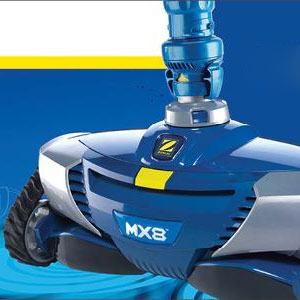
Zodiac MX8 is also a compact cleaner (40 x 18 x 9.5 inches). It has a blue body with grey accents and black tripoint truck wheels. For taking out this light cleaner (17.5 lbs), the blue handle on the back of the body is provided.
A yellow latch release button opens the top lid. The Zodiac is connected to a pool pump with the same plastic hoses via a port on the top.
The construction of the two cleaners is the same, with differences in design. They both are made from plastic but are different in colors. The ergonomic handle and additional wheels’ protection make Polaris Maxx the winner in this part of the comparison Polaris MAXX vs. Zodiac MX8.
Engine
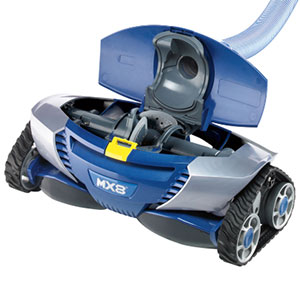
Zodiac has an energy efficient engine that works from 20 GPM flow. It pushes the flex power turbines to work ultra-efficiently.
The blades/paddies on the turbine can trap large debris that should be deleted. To access the blades, you need to open the lid. All debris can be deleted by rotating the paddies back and forth; no other maintenance is required.
Both cleaners have energy-efficient engines. But Polaris has two turbines, while Zodiac only has one. Also, the internals of Polaris cleaner ensure better passing of large debris. So, Polaris Maxx is again the winner in this part.
Brushes
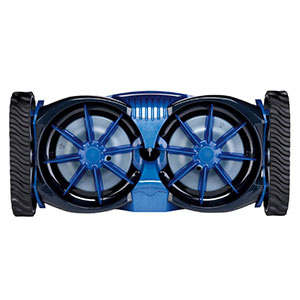
Zodiac on the bottom side of the cleaner has two brushes. They should be replaced each season or more often in case of damage.
The quantity and location of brushes is the same for both cleaners. But Polaris has two scrubbing brushes, while Zodiac only standard. Polaris Maxx is the winner.
How to choose the best suction side pool cleaner?
Your choice of the best suction-side pool cleaner should be thoughtful and based on the main factors determining its cleaning performance, durability, and price.
- How much money are you going to spend on your automatic pool cleaner? Your budget determines if you choose suction side cleaner or robotic.
- What is the size of your pool? The suction side cleaner’s hose length from a skimmer or a suction port should be enough to reach the farthest point of your pool.
- What is the typical debris size in your pool? Based on the debris sizes, you need to choose the cleaner, as it depends on the type of brushes (scrubbing brushes, for example, you need if you have a lot of algae or dirt on the pool’s walls and floor. If you have different debris sizes, you must choose a cleaner with an adjustable inlet.
- Is your pool pump sufficient to provide enough suction power for a suction side cleaner? Suction side cleaners are not independent automatic cleaners. Their suction power depends on their internal construction and your pump. Check the technical requirements of both before purchase. The most efficient suction cleaners require at least 20 GPM, which is low flow. The more powerful your pump is the better suction you will have at the cleaner.
- Are your filter and skimmer big enough to receive additional debris load from a suction side cleaner? Suction side cleaners do not have their debris bag or filter; if your filter and skimmer hardly work without a cleaner, you must buy a special leaf canister and install it on the cleaner’s hose or choose another type of automatic cleaner with your filter bag.
- Do you have a skimmer or a dedicated port for a vacuum line to connect a suction side cleaner? The suction-side pool cleaner can be connected in two ways: a skimmer or a vacuum line. You need to have one of these possibilities. The connection size is not so important; many adapters are available on the market.
Other parameters are optional but also should be considered: weight and dimensions (as you regularly need to take the cleaner out of the pool) and navigation (advanced navigation ensures full pool coverage for less time). For some owners, design, and color are crucial parameters as well.
Frequently Asked Questions
Can I leave my suction pool cleaner in the water for the whole week?
 It is not recommended to keep cleaner constantly in the water. This may cause their corrosion by pool chemicals.
It is not recommended to keep cleaner constantly in the water. This may cause their corrosion by pool chemicals.How long is the cleaning cycle of Zodiac MX8 and Polaris MAXX?
How much time is required to set up Polaris Maxx?
Why is my Zodiac MX8 not climbing?
Can a Zodiac MX8 operate at a temperature below 60 degrees F?
Conclusion
This article provides a detailed comparison of Polaris MAXX vs. Zodiac MX8. As we highlighted, these suction side cleaners differ only in minor things like design, number of turbines, type of brushes, and protection of wheels. Such differences do not significantly impact their cleaning performance. If you have a tight budget, we recommend the Zodiac MX8. But if you want to purchase the best of the best, choose Polaris Maxx. It is the winner in our face-to-face comparison in all parts. Nevertheless, these two models are among the best suction side cleaners on the market.

Hi! I’m Markus Robertson, and water is my passion.
Five years ago, I graduated from the University of California-Los Angeles and was going to become a professional marine biologist. However, my fate had other plans for me, and due to family problems, I had to find a more stable and well-paid job. I had only one wish for my job to be connected with water.
During this period of my life, I worked as a sales manager at Olympic Pool & Spa Supplies. The job helped me learn everything about swimming pools and related pool equipment, as well as how to choose the best option and what to pay attention to.



